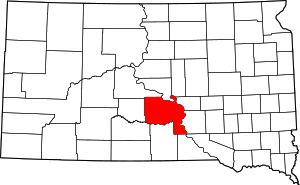Lower Brule, South Dakota
Lower Brule (Lakota: Khulwíčhaša[3]) is a census-designated place (CDP) in Lyman County, South Dakota, United States. The population was 613 at the 2010 census. This community is located within the Lower Brule Indian Reservation, from which it takes its name.[4]
Lower Brule, South Dakota | |
|---|---|
 Location in Lyman County and the state of South Dakota | |
| Coordinates: 44°4′26″N 99°34′51″W | |
| Country | United States |
| State | South Dakota |
| County | Lyman |
| Government | |
| • Type | Tribal Council |
| • Chairman/CEO | Boyd I. Gourneau |
| Area | |
| • Total | 0.4 sq mi (0.9 km2) |
| • Land | 0.4 sq mi (0.9 km2) |
| • Water | 0 sq mi (0 km2) |
| Elevation | 1,444 ft (440 m) |
| Population (2010) | |
| • Total | 613 |
| • Density | 1,532.5/sq mi (681.1/km2) |
| Time zone | UTC-6 (Central (CST)) |
| • Summer (DST) | UTC-5 (CDT) |
| ZIP code | 57548 |
| Area code(s) | 605 |
| FIPS code | 46-39180[1] |
| GNIS feature ID | 1256261[2] |
Geography
Lower Brule is located at 44°4′26″N 99°34′51″W (44.074014, -99.580716).[5]
According to the United States Census Bureau, the CDP has a total area of 0.4 square miles (1.0 km2), all of it land.
Lower Brule has been assigned the ZIP code 57548.
The reservation has a boat landing north of the city where walleyes and other fish can be caught. The local Indian tribe allows non-tribal members to hunt and fish within their reservation boundaries and there is an abundance of upland game birds to hunt during the fall.
The Lower Brule Sioux tribe operates a popcorn packaging business, and the casino in the area is called the Golden Buffalo.
Demographics
As of the census[1] of 2000, there were 599 people, 165 households, and 114 families residing in the CDP. The population density was 1,667.7 people per square mile (642.4/km2). There were 182 housing units at an average density of 506.7/sq mi (195.2/km2). The racial makeup of the CDP was 4.84% White, 0.17% African American, 94.82% Native American, and 0.17% from two or more races. Hispanic or Latino of any race were 0.33% of the population.
There were 165 households, out of which 46.7% had children under the age of 18 living with them, 21.2% were married couples living together, 34.5% had a female householder with no husband present, and 30.9% were non-families. 24.8% of all households were made up of individuals, and 6.1% had someone living alone who was 65 years of age or older. The average household size was 3.60 and the average family size was 4.30.
In the CDP, the population was spread out, with 44.2% under the age of 18, 9.8% from 18 to 24, 27.9% from 25 to 44, 13.9% from 45 to 64, and 4.2% who were 65 years of age or older. The median age was 23 years. For every 100 females, there were 95.1 males. For every 100 females age 18 and over, there were 96.5 males.
The median income for a household in the CDP was $18,750, and the median income for a family was $16,250. Males had a median income of $18,281 versus $19,107 for females. The per capita income for the CDP was $6,591. About 50.9% of families and 51.9% of the population were below the poverty line, including 56.2% of those under age 18 and 20.0% of those age 65 or over.
References
- "U.S. Census website". United States Census Bureau. Retrieved 2008-01-31.
- "US Board on Geographic Names". United States Geological Survey. 2007-10-25. Retrieved 2008-01-31.
- Ullrich, Jan, ed. (2011). New Lakota Dictionary (2nd ed.). Bloomington, IN: Lakota Language Consortium. p. 999. ISBN 978-0-9761082-9-0. LCCN 2008922508.
- Federal Writers' Project (1940). South Dakota place-names, v.1-3. University of South Dakota. p. 48.
- "US Gazetteer files: 2010, 2000, and 1990". United States Census Bureau. 2011-02-12. Retrieved 2011-04-23.
